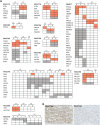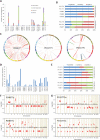Uncovering the genomic heterogeneity of multifocal breast cancer
- PMID: 25850943
- PMCID: PMC4691324
- DOI: 10.1002/path.4540
Uncovering the genomic heterogeneity of multifocal breast cancer
Abstract
Multifocal breast cancer (MFBC), defined as multiple synchronous unilateral lesions of invasive breast cancer, is relatively frequent and has been associated with more aggressive features than unifocal cancer. Here, we aimed to investigate the genomic heterogeneity between MFBC lesions sharing similar histopathological parameters. Characterization of different lesions from 36 patients with ductal MFBC involved the identification of non-silent coding mutations in 360 protein-coding genes (171 tumour and 36 matched normal samples). We selected only patients with lesions presenting the same grade, ER, and HER2 status. Mutations were classified as 'oncogenic' in the case of recurrent substitutions reported in COSMIC or truncating mutations affecting tumour suppressor genes. All mutations identified in a given patient were further interrogated in all samples from that patient through deep resequencing using an orthogonal platform. Whole-genome rearrangement screen was further conducted in 8/36 patients. Twenty-four patients (67%) had substitutions/indels shared by all their lesions, of which 11 carried the same mutations in all lesions, and 13 had lesions with both common and private mutations. Three-quarters of those 24 patients shared oncogenic variants. The remaining 12 patients (33%) did not share any substitution/indels, with inter-lesion heterogeneity observed for oncogenic mutation(s) in genes such as PIK3CA, TP53, GATA3, and PTEN. Genomically heterogeneous lesions tended to be further apart in the mammary gland than homogeneous lesions. Genome-wide analyses of a limited number of patients identified a common somatic background in all studied MFBCs, including those with no mutation in common between the lesions. To conclude, as the number of molecular targeted therapies increases and trials driven by genomic screening are ongoing, our findings highlight the presence of genomic inter-lesion heterogeneity in one-third, despite similar pathological features. This implies that deeper molecular characterization of all MFBC lesions is warranted for the adequate management of those cancers.
Keywords: breast cancer; genomic heterogeneity; multicentric; multifocal; oncogenic mutations; targeted sequencing.
© 2015 The Authors. The Journal of Pathology published by John Wiley & Sons Ltd on behalf of Pathological Society of Great Britain and Ireland.
Figures




Comment in
-
Breast cancer heterogeneity: parallel evolution or conscious uncoupling?J Pathol. 2015 Sep;237(1):1-3. doi: 10.1002/path.4557. Epub 2015 May 28. J Pathol. 2015. PMID: 25953517
References
-
- Salgado R, Aftimos P, Sotiriou C, et al. Evolving paradigms in multifocal breast cancer. Semin Cancer Biol 2015; 31: 111–118. - PubMed
-
- Wolters R, Wöckel A, Janni W, et al. Comparing the outcome between multicentric and multifocal breast cancer: what is the impact on survival, and is there a role for guideline‐adherent adjuvant therapy? A retrospective multicenter cohort study of 8,935 patients. Breast Cancer Res Treat 2013; 142: 579–590. - PubMed
-
- Tot T. Early and more advanced unifocal and multifocal breast carcinomas and their molecular phenotypes. Clin Breast Cancer 2011; 11: 258–263. - PubMed
-
- Bendifallah S, Werkoff G, Borie‐Moutafoff C, et al. Multiple synchronous (multifocal and multicentric) breast cancer: clinical implications. Surg Oncol 2010; 19: e115‐123. - PubMed
Publication types
MeSH terms
Substances
LinkOut - more resources
Full Text Sources
Other Literature Sources
Medical
Research Materials
Miscellaneous

